
If you cast your mind back to the late 1970s — those of us who can — New Zealand was in the grip of a fuel crisis, with carless days introduced in July 1979 and the open-road speed limit reduced from 100 kph to 80 kph.
Just eight weeks prior to that, then Prime Minister Rob Muldoon had announced without consultation a 20 percent sales tax to be levied on caravans and boats, putting both local industries into a freefall.
Many manufacturers quit and those that remained scrambled to find workable solutions. Liteweight Caravans, Don Jessen’s family business, responded by creating a 10ft by 6ft caravan with a fibreglass base reminiscent of a multi-chine boat.
Named the Pinto, it weighed in at a mere 500kg despite having four berths, a kitchen with fridge and stove, a wardrobe, and a dinette which converted to a double bed. It also had full head height.
Sitting around the canteen, conversation turned to what size car would be able to tow it. Don decided to put it to the test. Using a borrowed 1000cc Mini, Don and Marilyn set out on a road trip from Hamilton to Whitianga, on to Coromandel and Thames and back home to Hamilton again.
In those days, the roads from Whitianga to Coromandel were loose metal. Don and Marilyn were not entirely comfortable about how it would perform, so they hedged their bets with a back-up car driven by friends who took photos and video to prove they made it.
The Mini handled the road trip beyond expectations, returning a fuel consumption of 26 miles per gallon. Not bad for towing. This highly memorable trip became the inspiration for the title of this book: My Mini Could Tow That! But the story continues.
So impressed was Don that he next hooked the Pinto to a 185cc Honda farm trike and towed it across the loose metal hills of Old Mountain Road over the Raglan deviation. Undertaken in pouring rain, the Pinto trip was again recorded as highly successful, with the rig hitting 70 kph on the short straights.
The ultimate conclusion — the Pinto could be towed anywhere in New Zealand with a small car. Not all tiny caravans were made in response to the fuel crisis. Jackson Caravans released their Cub in 1959, proudly advertising it as towable by a Mini.
A number of other manufacturers, including Lilliput, Clipper, Explorer and Pioneer, produced small caravans, some as tiny as 8 ft long. Six years later, in 1986, Liteweight produced the Caravette, a reverse teardrop weighing in at around 250 kg.
Little did Don know that many years later he would own a Caravette, which he towed behind his 1300 cc Kawasaki Voyager motorbike and sidecar rig, with two adults on the bike and two kids in the sidecar.
In recent years, teardrops of all shapes and sizes have undergone something of a revival. It started in Australia with the restoration of teardrops from the 1940s.As stock got harder to find, new builds came to the fore with the involvement of both manufacturers and homebuilders testing their DIY skills.
Picking up on worldwide trends, New Zealanders also embraced the teardrop, but with no vintage stock available in New Zealand, they had to resort to building them from scratch, often from the original plans of the forties and fifties, found on the internet.
The usage of tiny spaces and the appeal of good design have always captured our imagination, and we are not alone. Our travels have connected us with numerous people who are also fascinated by the teardrop and tiny caravan movement. Whether you are a member of the group or a bystander, you cannot help but be drawn to the cuteness of these small holiday rigs.
Steve & Lisa
1957 Starliner Starlette 8 foot: The Donut Caravan
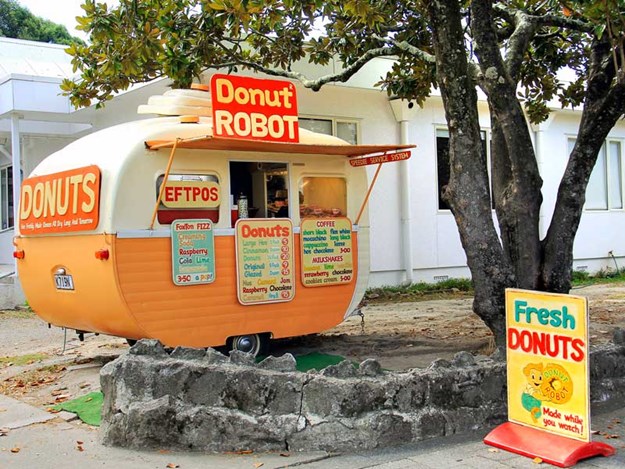 |
Steve & Lisa’s donut caravan |
While cruising through Napier, we spotted this tiny little caravan in town. It obviously sold donuts. Unfortunately, it was shut at the time and as we were under some pressure to get up the coast to Gisborne, we let it be.
However, some little caravans tend to get under your skin, and so it was with this little honey. Neither of us could get it out of our minds, so when we attended the Art Deco Festival in Napier, we made a beeline for the Donut Starlette.
It is such a little cutie. Steve, the owner, originally saw the Starlette for sale on Trade Me, had a ‘Eureka’ moment and bought it. Right from the start, he intended to turn it into a donut caravan.
The caravan was covered in moss and lichen and chooks had been roosting in it. A waterblast of the fibreglass and aluminium shell performed what seemed to be a miracle with the result being a caravan that was very straight and in amazing condition.
The chassis was excellent, needing no work at all. The caravan was a three berth and had the wardrobe mounted on the inside of the door, a very clever use of space by the manufacturer.
Judging by all the South Island stickers on the back window, the little caravan had obviously sallied forth from its Wellington home and toured extensively throughout the Mainland. Steve’s plans were to be put on hold for a number of years after he damaged his knee, resulting in multiple operations to get him on his feet again.
Back on the job, he stripped the interior of furniture, took out the offside windows and fitted a servery hatch and then repainted the caravan inside and out. New furniture was built to suit, and he imported a donut-making machine from Queens in New York City, a borough renowned for its donut cafés.
Steve has been operating for three years now and is very popular with tourists and locals. The cruise ships anchoring off Napier often bring many Americans, and they are totally gobsmacked when they see the tiny Starlette.
Their American Travel Trailers, as they call caravans, generally start at about 13 feet, so they have some trouble comprehending an 8-foot travel trailer. They just don’t believe Steve when he tells them that it used to sleep three people.
Just to confuse people even more, Steve often parks his Fiat 500 Bambina beside the Starlette. It looks picture perfect. Tourists take heaps of photos of his Donut Starlette, and Steve says if he sold the same amount of donuts as the tourists take photos, he would be able to retire!
David & Sally
1972 Anglo Imp 10 Foot
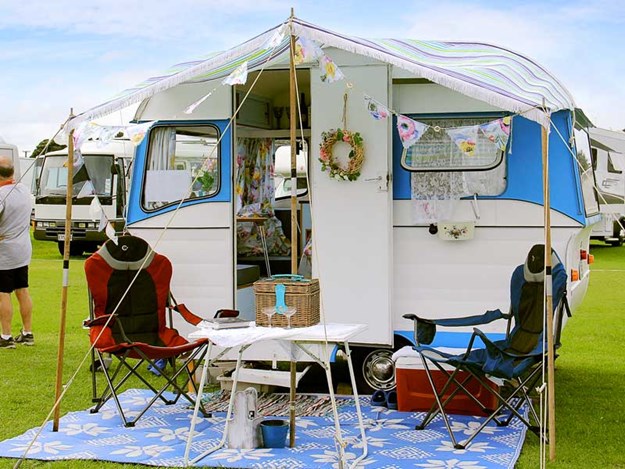 |
Florence |
Sally and David bought the Anglo Imp in 2016, naming it Florence, after Sally’s grandmother. Sally had a big passion to own a small retro caravan and an inheritance meant they suddenly had some money to buy one. They weren’t particularly set on an Imp, just a small caravan.
Their driveway and storage space are limited so that was also a determining factor. Against all sensible advice and better judgement, Sally bought the caravan sight unseen via Trade Me and had it delivered from Hawke’s Bay.
They very nervously awaited its arrival, which on first inspection was pretty much as they had expected. They cleaned it up a bit, then went away to a local site for the weekend to discover all those quirks you only find out about when you use a caravan.
On returning home, Sally and David were faced with a dilemma: should they keep it authentic or add their own touches to it? Some of the materials in the caravan, such as the squabs, curtains, walls and floor, Sally felt were unhygienic and so over the next six months they painted the caravan inside and out, moving away from the traditional early seventies look and using brighter more modern colours with a vinyl floor covering which simulates distressed wooden planks.
The next step was to have the caravan rewired and LED lighting and USB ports installed. The decision was made to keep all the original cabinetry but paint it in a striking blue, edged in the original natural timber.
The effect is quite stunning and has transformed the interior of the caravan. As Sally was able to make curtains and cushions, she decided to make three sets: a sweet pea floral look for the summer months; and a warmer tartan for winter; for December Florence is dressed with Christmas curtains complete with a tree.
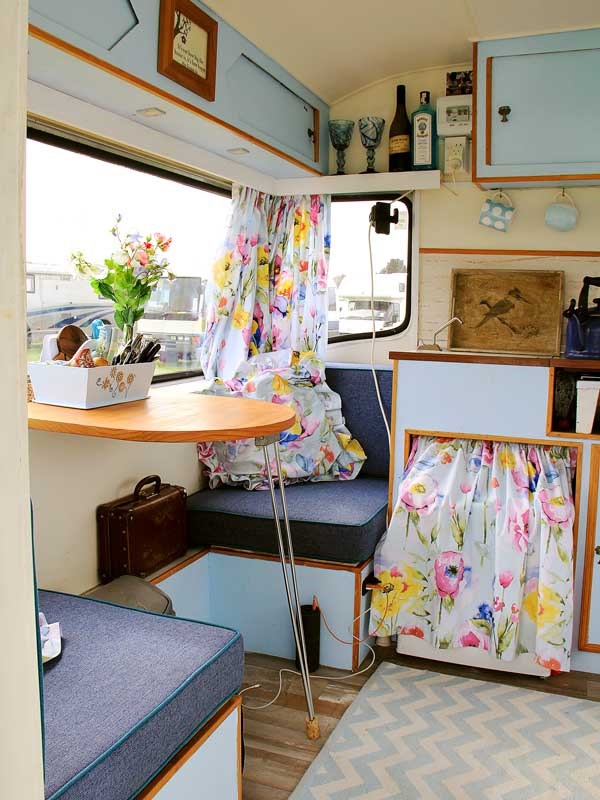 |
Inside Florence |
After the Brown’s Bay Santa Parade Florence is used by Santa as a base. Children can go inside and find colouring books, read Christmas story books and sit in Santa’s caravan while waiting for their turn to tell the man in red their Christmas wishes.
Sally and David’s son got married in September 2019 and the caravan was used at the venue as a children’s time-out area. Yes, Sally does have to go around with a cloth removing sticky finger marks after these events, but generally the children are pretty good.
Sally makes sure she packs away anything remotely interesting to remove any temptations to touch! So far there’s been no damage. Sally and David generally use Florence for weekend trips away, but the longest stay has been just over a week.
The caravan tows well and is fairly low maintenance. It stays dry inside, and they are amazed that on a hot summer’s day it’s no hotter inside than the outside, although a fan does help. In winter they use a small heater in the evening to keep warm.
There is no toilet, so they have to stay where there are facilities. The caravan has a large awning and small sun canopy which extends their living area. It’s a cosy arrangement for two.
Sally and David always relax when away, and they usually take their small dog, Gypsy, and love travelling through New Zealand staying in some stunning locations and meeting other retro caravan owners with their ‘wobble boxes’! Now that’s a name we haven’t heard retro caravans called before!
Deirdre (Dee)
1976 Ci Munro Sprite 10 Foot
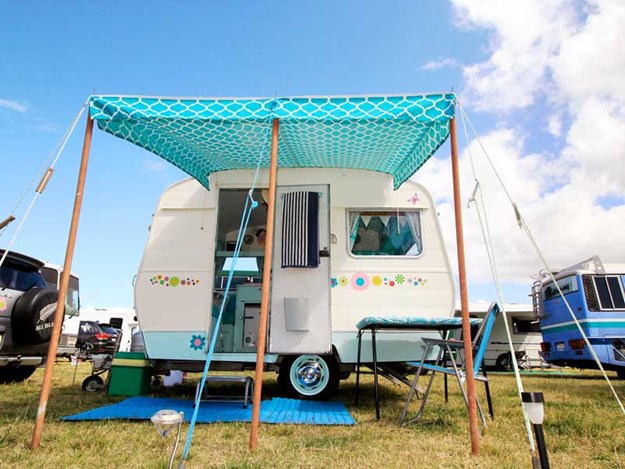 |
Dora the caravan |
Something Dee always wanted to do was to go caravanning. In early 2015 she saw a dear little vintage Sprite advertised on Trade Me. It was at Dairy Flat just north of Auckland. She liked the traditional shape and the fact that it needed only a superficial makeover.
In fact, that was part of the attraction, as it would allow Dee to personalise the caravan. Her niece checked it out for her, and Dee travelled to Auckland from the Wairarapa to pick it up. When Dee got it home, she started with replacing the curtains.
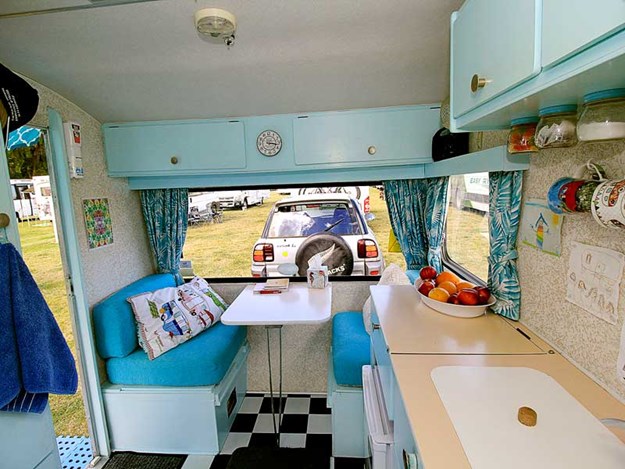 |
Inside Dora |
Then she painted the outside blue and white. The furniture was repainted in blue as well, but Dee had the blue paint lightened ten times the shade of the exterior blue. The paint supplier named this new colour ‘Dora’s Delight’ after the name Dee had given the caravan, which is short for Dora the Explorer.
Dee also decided that some flowers on the outside of Dora would look pretty cool and also help personalise her little caravan.After some internet research, she sent some base colours off to English company Hippy Motors, who developed the flowers and returned them to Dee.
The original awning was well past its use-by date so, utilising the original awning poles, Dee made herself a roof awning for the wee Sprite. The interior has many inspired additions. There are the glass jars under the overhead which hang from their screw lids, and caravan mugs which hang from cup hooks screwed into the wall, both of which travel perfectly.
The wardrobe mirror has been moved to the inside of the wardrobe door and a lovely picture now takes pride of place on the exterior of the wardrobe door. There are crocheted blankets, colourful cushions and blue bunting, all of which add to the homely and inviting feeling in the caravan.
Dee redid the floor with black and white tiles she bought from Mitre 10. It cost $36 for the whole floor. A freshwater tank was already fitted under the chassis and Dee installed a portable toilet under one of the single dinette bunks at the front of the caravan in order to be certified self-contained.
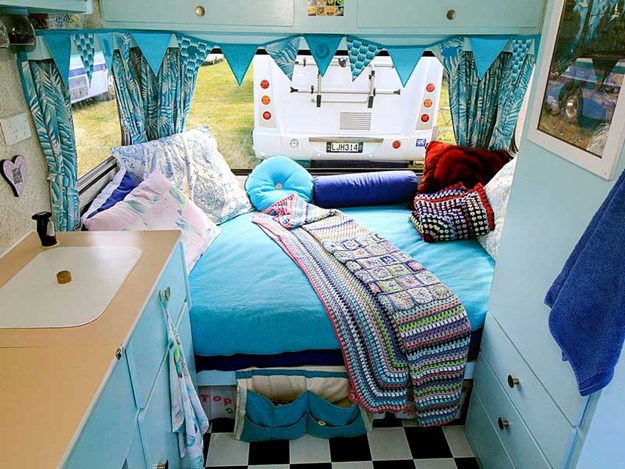 |
Dora’s comfy double bed |
The back pull-out double bed/couch has been turned into a permanent double bed. The vinyl coverings on the ceiling and wall were in mint condition and have been left original. Dee is in her early seventies and lives in a lifestyle village.
She has carried out this refurbishment on a limited budget entirely by herself, other than fixing a recent small ceiling leak. Not wanting to climb up on the roof, she sent out an email to the villagers advertising for a man to repair the leak. She said he didn’t have to be dark and handsome, but he needed to be tall.
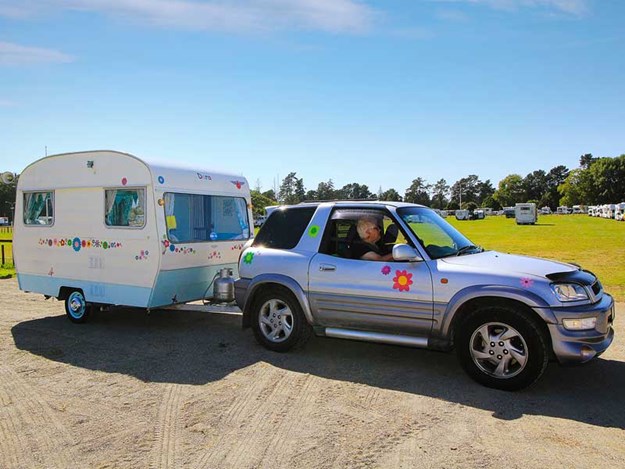 |
Dee and Dora on the move |
She had several applicants and chose one who did a great job of fixing the leak. It cost Dee a plate of home-cooked muffins. Dora is a great example of what can be achieved on a limited budget with a good dose of creativity. As her lifestyle and budget allows, Dee gets away in Dora as much as possible. It just goes to show retro caravanning is within everyone’s means and capabilities.
Michael
Mini Camper S
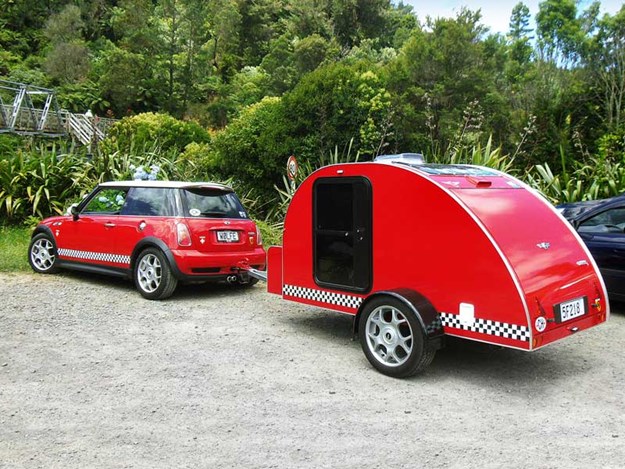 |
Michael’s Mini Camper S |
Michael built his teardrop camper to match his Mini Cooper S tow car, naming it a Mini Camper S. Considerable thought went into its design and construction.
Like the Mini car, the camper can accommodate four people, despite a floor plan of just 2.4 by 1.2 metres. The secret is the large awning of 8 square metres, which houses another two beds, a table and four chairs, and a toilet and shower.
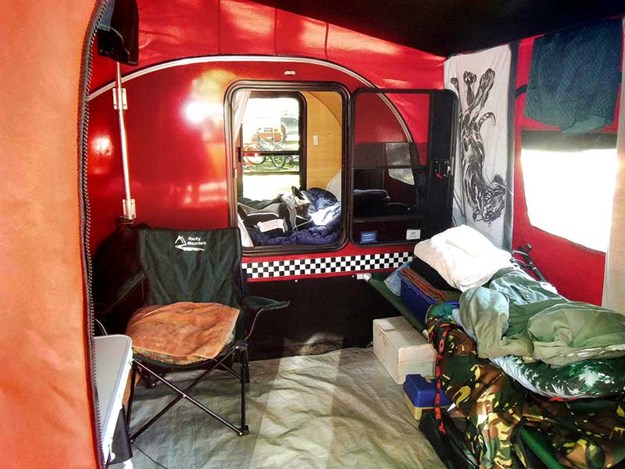 |
The awning adds extra space |
It boasts more amenities than many larger caravans. Michael has fitted a 75-litre freshwater tank with the same capacity grey-water tank. A 120-watt solar panel charges the battery, which in turn powers a 1200-watt, 240-volt inverter. There are four 240-volt power points, two on the inverter and two on the mains.
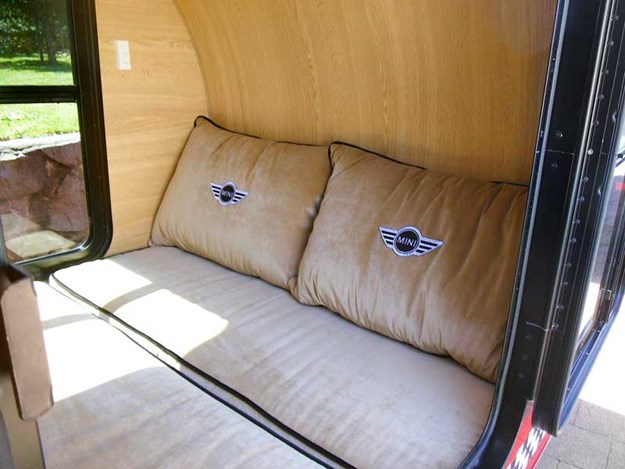 |
Inside the Mini Camper S |
The joinery has been constructed in imported American oak, which is just beautiful. Inside is a full entertainment system featuring a stereo/radio, CD player, TV and DVD player along with a PC with wireless keyboard. The rear kitchen, likewise, has everything you might need. The gas cooker slides out and locks in position with theclick of a button.
 |
The rear kitchen |
The fridge is two way: 12 volt and electric. Water through the tap is filtered and ready to drink. The Mini Camper S has a lot of storage designed into it both inside and out and features an attractive travel box at the front for electrics, gas bottle and camping gear.
The exterior doors either side of the teardrop were imported especially for the rig from the United States. The body is fully insulated. The wheels match the Cooper S rims and are fitted with run flat tyres. The wheel track on the teardrop was intentionally designed to match that of the Mini tow car.

The cost of the build was around $15,000 for parts and materials and it consumed around 1000 hours of labour. The finished product and its style and functionality are a credit to Michael’s talents.
The Mini Cooper S puts out about 175 brake horsepower as it is the powerful six-speed supercharged version, so it pulls the teardrop easily. In fact, according to Michael, he hardly knows it’s there. The matched Mini and Teardrop outfit look stunning in bright red and together are a real eye-catcher!





